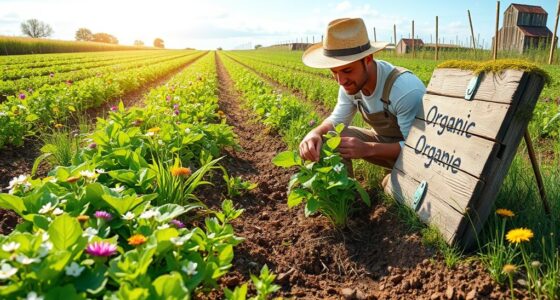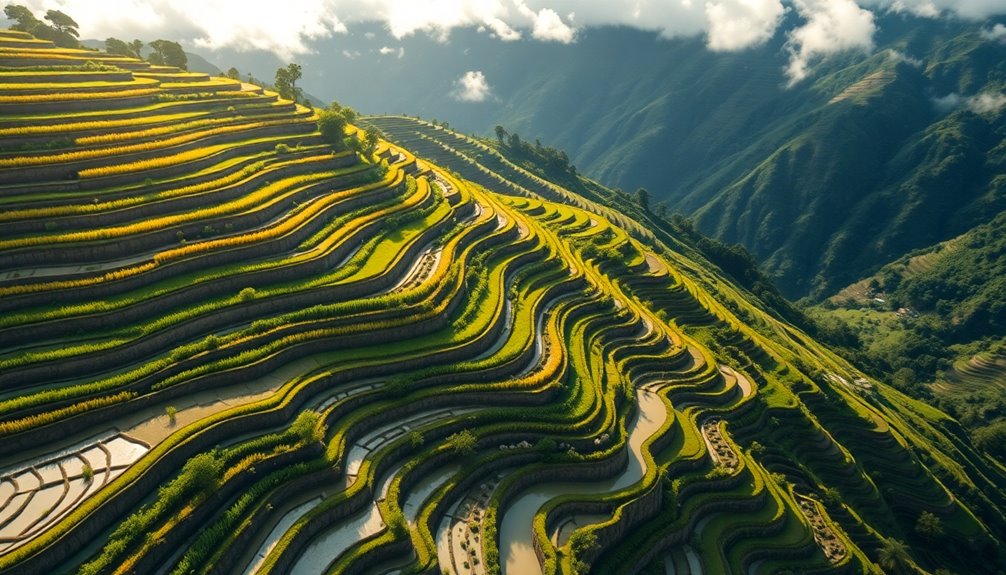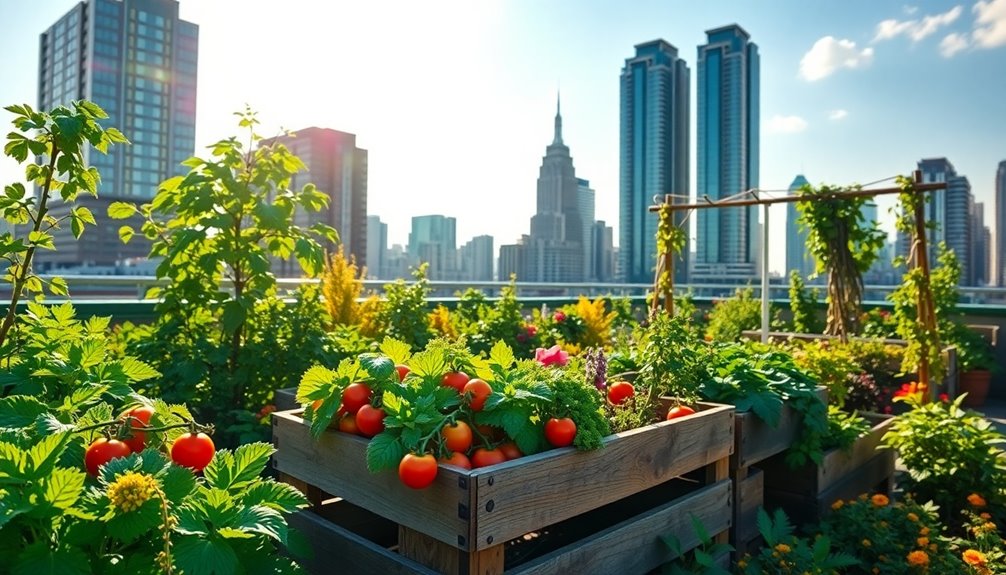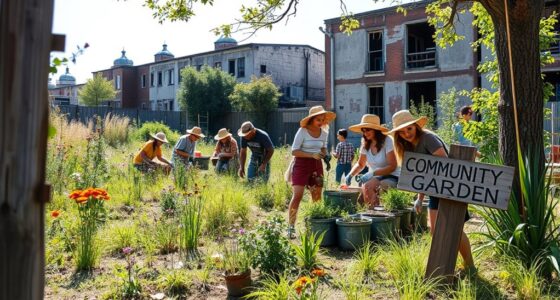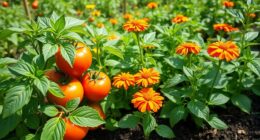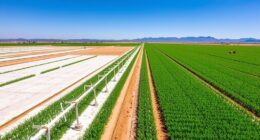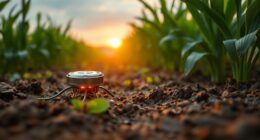Aquaponics is an efficient farming system where you grow plants and raise fish together in a closed-loop environment. Fish waste provides nutrients for the plants, and healthy plants help keep the water clean for the fish. It’s perfect for homesteaders looking to save resources, space, and money while producing fresh food. As you explore further, you’ll discover how to set up and maintain this sustainable system for your homestead.
Key Takeaways
- Aquaponics combines fish farming and plant cultivation in a sustainable, symbiotic system ideal for small-scale homesteads.
- Key components include a fish tank, grow beds, water circulation, and media supporting plant roots.
- Hardy fish like tilapia or goldfish are recommended for easy maintenance and system stability.
- Plants such as leafy greens and herbs absorb nutrients from fish waste, reducing external fertilizers.
- Regular monitoring of water quality and system components ensures healthy, productive aquaponic systems.
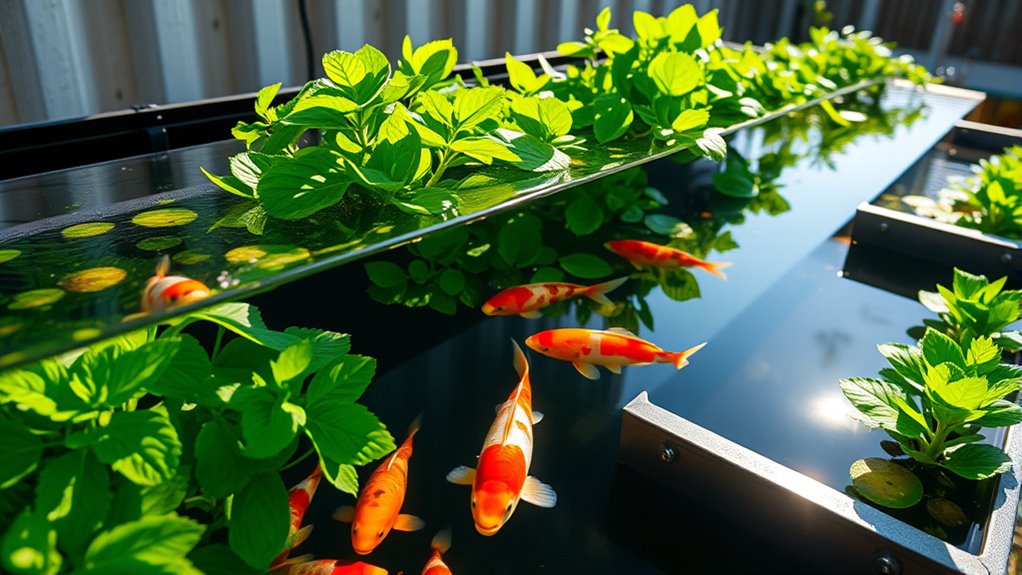
Aquaponics offers homesteaders an efficient way to grow fresh vegetables and raise fish simultaneously, saving space and resources. With this system, you create a symbiotic environment where fish and plants support each other’s growth. The core components include a fish tank, where your aquatic life resides, and grow beds, where plants thrive using nutrient-rich water from the tank. You can set up a compact, scalable system that fits your available space, making it an ideal solution for small farms or backyard homesteads.
Aquaponics enables sustainable, space-saving farming for homesteaders with integrated fish and plant systems.
The fish tank is the heart of your aquaponics system. It’s where your fish live, and their waste provides nutrients for your plants. You’ll want to choose fish that are hardy and easy to care for, such as tilapia or goldfish, and guarantee the tank is appropriately sized for your intended fish population. Maintaining water quality is vital; regular testing and filtration help keep ammonia, nitrite, and nitrate levels in check. The health of your fish directly impacts the nutrient supply for your grow beds, so proper aeration and temperature control are essential. Durable materials are recommended for constructing your fish tank to ensure longevity and safety. Additionally, incorporating advanced filtration systems can further enhance water clarity and quality, supporting a healthier environment for your aquatic life. Regularly inspecting and maintaining your system prevents issues and promotes a thriving ecosystem, which is especially important for beginners. To optimize your setup, understanding aquaponic cycle processes can help maintain a balanced environment and increase productivity. Moreover, understanding water testing techniques is crucial to keeping your system running smoothly and avoiding problems before they escalate.
Connected to the fish tank are the grow beds, which hold your plants. These beds are typically filled with a growing medium like clay pebbles or gravel that supports plant roots. As water circulates from the fish tank to the grow beds, plants absorb nutrients from the water, filtering and cleaning it in the process. After the plants take up the nutrients, the water is returned to the fish tank, creating a closed-loop system. This cycle means less water usage compared to traditional gardening, and it reduces the need for external fertilizers.
Getting started with aquaponics involves balancing your system’s components. You’ll need to determine the right fish stock, set up a reliable water circulation system, and select suitable plants. Leafy greens like lettuce, kale, and herbs tend to grow quickly and are well-suited for aquaponic systems. As you gain experience, you can expand your grow beds or add different fish species. Monitoring water parameters regularly helps prevent issues like algae blooms or fish stress, guaranteeing your system stays healthy and productive. To ensure long-term success, it’s advisable to learn about system maintenance and troubleshoot common problems early.
Frequently Asked Questions
What Are the Initial Costs of Setting up an Aquaponics System?
Starting an aquaponics system involves initial costs that depend on your budget considerations and equipment essentials. You’ll need tanks, grow beds, pumps, and plumbing, which can vary in price. Expect to spend a few hundred to over a thousand dollars, depending on system size and quality. Planning ahead helps you prioritize essential equipment and manage expenses effectively, ensuring your setup is functional without overspending.
How Much Space Is Needed for a Beginner Aquaponics Setup?
Think of your aquaponics system as a garden seed—small at first but with room to grow. For beginners, start with about 10 to 20 square feet, enough for a basic setup. This space allows for system scalability and easy space optimization as you learn. You can expand as your confidence grows, turning your humble beginning into a thriving, self-sustaining oasis.
What Fish Species Are Best for Small-Scale Homestead Aquaponics?
When choosing fish for small-scale homestead aquaponics, focus on fish selection and species compatibility. Tilapia is popular because it’s hardy, fast-growing, and tolerates varying water conditions. Catfish also work well, especially in warmer climates. Trout and goldfish are suitable if your system’s temperature permits. Always consider your local climate, water temperature, and tank size to make certain your fish thrive and stay compatible with your plants and system.
How Do I Maintain Water Quality in My Aquaponics System?
Think of your aquaponics system as a delicate dance—water quality keeps the rhythm. You’ll want to regularly check pH balancing to keep it in the sweet spot, around 6.8 to 7.0. Incorporate biofiltration techniques like biofilters or grow beds to naturally purify the water. Change water sparingly, and watch for signs of imbalance, so your fish and plants can thrive in harmony.
Can Aquaponics Be Integrated With Existing Gardening Practices?
Yes, you can integrate aquaponics with your existing gardening practices. Use companion planting to enhance pest control and plant health, and incorporate soil amendments to enrich your garden soil where needed. Aquaponics complements traditional gardening by providing nutrient-rich water for soil plants, reducing fertilizer use. This synergy helps you maximize yields, improve plant health, and create a more sustainable, diverse garden system that works seamlessly together.
Conclusion
So, now you’re all set to turn your backyard into a fishy, leafy paradise. Who knew growing food could be this effortless? Just remember, with aquaponics, you’re basically creating a tiny, self-sustaining ecosystem—no green thumb required. So go ahead, impress your friends with your futuristic farm. Just don’t forget to feed the fish and pretend you’re some sort of eco-genius. After all, what’s more satisfying than playing god with water and plants?



